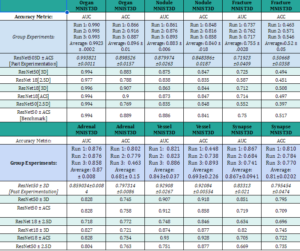Week 8: Initial Results – Numbers – What do they really mean?
Andrew Y -
Hello everyone,
This week, I’ve gotten results for the Medministv2 3D datasets using classification and segmentation results. Here is the graph below.

Now, you may be wondering, what do any of these results mean, and how can I interpret it.
Here’s a descriptive glossary into one each of these terms mean from the results.
- ResNet: A type of powerful computer program used for understanding and recognizing images, often used in things like facial recognition and self-driving cars.
- Autokeras: A tool that helps computers learn by themselves, like when you teach a computer to recognize patterns without having to explicitly program every detail.
- ACC (Accuracy): How often a computer program gets things right when it’s trying to make decisions or classify things, like identifying if an email is spam or not.
- AUC (Area Under the ROC Curve): A way to measure how well a computer program can tell the difference between different things, like distinguishing between healthy and unhealthy cells in medical images.
- Google AutoML Vision: A tool created by Google that makes it easier for people to train computers to recognize images, useful for tasks like identifying animals in pictures or detecting objects in photos.
- Test Results: The outcomes or grades of how well a computer program performs when it’s tested on new data it hasn’t seen before, to see how good it is at what it learned.
- Train Results: The outcomes or grades of how well a computer program performs when it’s tested on the same data it learned from, to see how well it remembers what it was taught.
- 2.5D: A technique in computer graphics and imaging that simulates three-dimensional effects using two-dimensional images or displays, often seen in video games and virtual reality environments.
- Standard Deviation: A measure of the amount of variation or dispersion in a set of values, indicating how much individual values differ from the mean (average) value. It helps understand the spread of data points in a dataset.
- Runs: Amount of times an experiment is repeated.
Here are also some responses to some FAQ regarding results:
Why aren’t there any experimental results with an accuracy of 1?
- Getting perfect results in real-world experiments is rare because there are often small mistakes or uncertainties that affect the outcome.
Why is it that ML Models need to train first and then run after?
- ML models learn from examples during training to make accurate predictions later. It’s like teaching a computer by showing it many examples before it can understand and answer questions.
Why do ML models need to run multiple times?
- Running ML models several times helps make sure they work well in different situations and with different data. It’s like practicing a skill to get better at it.
Why is it important to compare to other results below?
- Comparing ML results to others helps us see how good our model is compared to what’s already out there. It’s like checking if your score in a game is better than your friends’ scores to know how well you did.
Next week, I plan to update the 2D datasets results. If you have any questions, feel free to ask!
– Adios!
Andrew

Comments:
All viewpoints are welcome but profane, threatening, disrespectful, or harassing comments will not be tolerated and are subject to moderation up to, and including, full deletion.